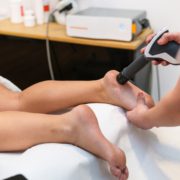Could Regenerative Therapy be the Future of Healing for Active Adults?
Staying fit and injury-free is essential for maintaining an active lifestyle – especially when you’re over 40.
And the more active you are, the better your quality of life tends to be. But here’s the unavoidable reality… As your body ages, so do your natural healing processes. Translation? Recovery times take longer than when you were in your 20s – and you become more vulnerable to injuries as you age.
Fortunately, an emerging field in medicine is gaining popularity and could be the solution to longevity you’ve been searching for. It’s called regenerative therapy. This cutting-edge field focuses on harnessing the body’s natural ability to heal and regenerate itself. Regenerative therapy includes treatments like stem cell therapy, platelet-rich plasma (PRP) therapy, regenerative shockwave therapy, and electromagnetic therapies such as Pulsed Electromagnetic Field Therapy (PEMF) and Extracorporeal Magnetotransduction Therapy (EMTT). These therapies aim to repair damaged tissues, reduce inflammation, and stimulate the production of new, healthy cells.
For the purposes of this article – let’s focus on two of these regenerative therapies – Shockwave Therapy and EMTT – and how when used together – deliver incredible results for active adults over 40.
Compared to some of the other regenerative therapy options out there – this treatment combo is non-invasive, highly accessible, and affordable. Plus – it comes with minimal side effects, no contraindications for most people, and virtually no downtime required – making it a game-changer for those who want to stay active without interruptions to their daily lives.
Let me introduce you to Regenerative Shockwave Therapy and EMTT…
What is Shockwave Therapy?
Extracorporeal Shockwave Therapy (Shockwave Therapy) is a non-invasive procedure that uses acoustic shockwave energy to stimulate healing in tendons and soft tissues. Radial Shockwave Therapy (EPAT) disperses energy broadly over an area – while Focused Shockwave Therapy (ESWT) concentrates energy on a smaller, more precise area. Both types of shockwave therapy stimulate healing by enhancing blood flow, promoting cell and tissue regeneration, reducing inflammation, and breaking down scar tissue. Originally developed to break up kidney stones, shockwave therapy has been used for decades to treat musculoskeletal conditions like tendinitis and plantar fasciitis.
What is EMTT?
Extracorporeal Magnetotransduction Therapy (EMTT) is an advanced, non-invasive, cutting-edge treatment that uses high-energy electromagnetic fields to accelerate healing and alleviate pain. It’s often compared to Pulsed Electromagnetic Field Therapy (PEMF), but it’s much more powerful. While both therapies rely on electromagnetic fields to stimulate natural repair processes – EMTT operates at frequencies up to 100 times higher than PEMF – enabling it to penetrate deeper into tissues and deliver more targeted therapeutic effects. EMTT has the capability to heal at the cellular level by enhancing your cell’s metabolic activity, which helps to reduce inflammation, promote faster healing, and accelerate the regeneration of damaged tissue. EMTT’s increased energy and intensity make it so powerful it can penetrate through clothing and even a cast (when bone healing is needed). Its high frequency also makes it virtually painless. EMTT is particularly effective for chronic pain, joint injuries, and degenerative conditions like arthritis
The Power of Shockwave Therapy and EMTT combined:
While Shockwave Therapy has been around for over 40 years – EMTT is fairly new to the market of regenerative therapies. The first EMTT device, the Magnetolith, was FDA-approved in the United States in 2010. Since then – the two therapies have proven to be a perfect pair. When combined – Shockwave Therapy and EMTT offer a powerful, synergistic approach to healing. While Shockwave Therapy focuses on mechanical stimulation of your tissues and improving circulation – EMTT works at a cellular level, resetting inflammation and promoting deeper tissue repair. Together – these therapies amplify each other’s effects – resulting in faster and more comprehensive healing.
Evidence Supporting the Combo:
A 2018 study by Kluter et al. examined the effects of Shockwave Therapy alone versus Shockwave Therapy combined with EMTT on 86 patients with rotator cuff tendinopathy. The results showed that patients receiving the combined therapy experienced significantly greater pain reduction and improved function compared to those treated with Shockwave Therapy alone. Although EMTT is relatively new, preliminary studies and case reports highlight its potential. For example – regenerative therapy using Shockwave Therapy and EMTT has shown promise in improving surgical outcomes. Case studies demonstrate that pre- and post-operative use of this combo significantly enhances scar healing, bone healing, and recovery times. And patients undergoing major procedures like Achilles tendon repairs returned to activity almost two months faster when these therapies were included as part of their recovery.
So Who Can Benefit?
The short answer is literally anyone. But active adults over 40 are prime candidates for this combination of regenerative therapies. Post-surgical patients recovering from orthopedic surgeries – including joint replacements – can experience faster healing and improved outcomes. Chronic pain sufferers dealing with conditions like arthritis or tendinopathies can find relief where other treatments have failed. Athletes or active adults with sports injuries, muscle strains, or overuse injuries will also benefit. And finally – if you’re someone who’s recovery has stalled with traditional physical therapy or cortisone injections – you might just find renewed hope with this advanced, cutting-edge treatment.
As research into regenerative medicine advances – I believe the combined use of Shockwave Therapy and EMTT is poised to become a cornerstone of modern healthcare for active adults. These therapies not only address the symptoms of injury and degeneration – but also tackle the underlying causes – promoting true healing and long-term recovery. For active adults over 40 who want to maintain their mobility, independence, and active lifestyles – regenerative therapy offers a promising future. By harnessing the body’s natural healing capabilities through advanced, non-invasive techniques – Shockwave Therapy and EMTT provide a path to faster recovery, improved surgical outcomes, and a pain-free life.
If you’re over 40 and facing chronic pain, injury, or the prospect of surgery – consider exploring regenerative therapy.
The combination of Shockwave Therapy and EMTT isn’t just about managing symptoms – it’s about restoring your body’s ability to heal itself.
With growing evidence supporting their effectiveness, these therapies are paving the way for a healthier, more active future for adults everywhere.
Are you local to Portsmouth, NH?
Book a free discovery visit with one of my specialists to see if you could be a good fit for our Regenerative Therapies by clicking HERE.
Dr. Carrie Jose, Physical Therapy Specialist, and Mechanical Pain Expert, owns CJ Physical Therapy & Pilates in Portsmouth, NH, and writes for Seacoast Media Group. If local to Portsmouth, NH, and looking for help – request a FREE Discovery Visit with one of her Specialists by CLICKING HERE.





